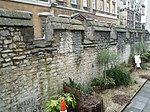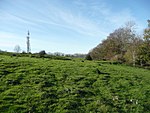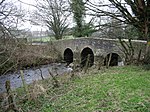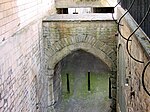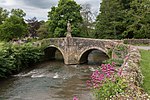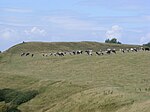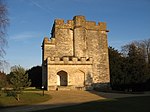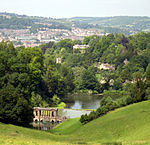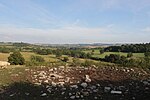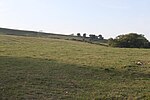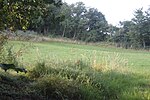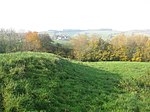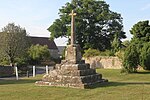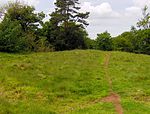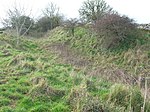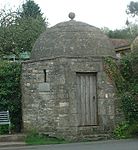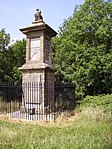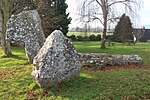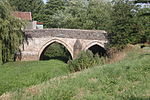List of scheduled monuments in Bath and North East Somerset: Difference between revisions
m Replace East Gate picture with higher-resolution version of same. |
Rescuing 2 sources and tagging 0 as dead. #IABot (v1.5.4) (FA RotBot) |
||
| Line 545: | Line 545: | ||
| upload_desc = <!-- Default to {{Unlink|{{{name|}}}}}. --> |
| upload_desc = <!-- Default to {{Unlink|{{{name|}}}}}. --> |
||
| show_ref = yes <!-- if using reference column --> |
| show_ref = yes <!-- if using reference column --> |
||
| reference =<ref>{{cite web|last=Bull|first=Larry|title=On Stanton Drew, Avebury and Stonehenge|url=http://www.bit.uwe.ac.uk/~lbull/stanton.html|publisher=University of the West of England|accessdate=1 December 2013}}</ref><ref>{{cite book|last=Pollard|first=Joshua|editor-last=Webster|editor-first=C.J.|title=The Archaeology of South West England |
| reference =<ref>{{cite web|last=Bull|first=Larry|title=On Stanton Drew, Avebury and Stonehenge|url=http://www.bit.uwe.ac.uk/~lbull/stanton.html|publisher=University of the West of England|accessdate=1 December 2013}}</ref><ref>{{cite book|last=Pollard|first=Joshua|editor-last=Webster|editor-first=C.J.|title=The Archaeology of South West England|year=2008|chapter=Chapter 4 Neolithic and Early Bronze Age|url=http://www1.somerset.gov.uk/archives/hes/downloads/swarf_4.pdf|format=PDF|publisher=Somerset County Council|accessdate=12 December 2013|isbn=978-0-86183-392-4|pages=75–102|deadurl=yes|archiveurl=https://web.archive.org/web/20131202235444/http://www1.somerset.gov.uk/archives/hes/downloads/swarf_4.pdf|archivedate=2 December 2013|df=dmy-all}}</ref><ref>{{cite web|title=Two stone circles and two stone avenues at Stanton Drew, east of Court Farm|url=http://list.english-heritage.org.uk/resultsingle.aspx?uid=1007911|work=National Heritage List for England|publisher=English Heritage|accessdate=11 December 2013}}</ref> |
||
| commonscat = Stanton Drew stone circles |
| commonscat = Stanton Drew stone circles |
||
| show_wikidata= no |
| show_wikidata= no |
||
| Line 1,002: | Line 1,002: | ||
| upload_desc = <!-- Default to {{Unlink|{{{name|}}}}}. --> |
| upload_desc = <!-- Default to {{Unlink|{{{name|}}}}}. --> |
||
| show_ref = yes <!-- if using reference column --> |
| show_ref = yes <!-- if using reference column --> |
||
| reference =<ref>{{cite web|last1=Brown|first1=Graham|title=Richmont Castle, East Harptree: An Analytical Earthwork Survey, English Heritage Research Department Report No. 73|url=http://services.english-heritage.org.uk/ResearchReportsPdfs/073_2008WEB.pdf|format=PDF|publisher=English Heritage|accessdate=28 July 2014}}</ref> |
| reference =<ref>{{cite web|last1=Brown|first1=Graham|title=Richmont Castle, East Harptree: An Analytical Earthwork Survey, English Heritage Research Department Report No. 73|url=http://services.english-heritage.org.uk/ResearchReportsPdfs/073_2008WEB.pdf|format=PDF|publisher=English Heritage|accessdate=28 July 2014|deadurl=yes|archiveurl=https://web.archive.org/web/20140812205322/http://services.english-heritage.org.uk/ResearchReportsPdfs/073_2008WEB.pdf|archivedate=12 August 2014|df=dmy-all}}</ref> |
||
|- |
|- |
||
| commonscat = |
| commonscat = |
||
Revision as of 11:29, 30 September 2017

Bath and North East Somerset (commonly referred to as BANES or B&NES) is a unitary authority created on 1 April 1996, following the abolition of the County of Avon, which had existed since 1974.[1] Part of the ceremonial county of Somerset, Bath and North East Somerset occupies an area of 220 square miles (570 km2), two-thirds of which is green belt.[2] It stretches from the outskirts of Bristol, south into the Mendip Hills and east to the southern Cotswold Hills and Wiltshire border.[2] The city of Bath is the principal settlement in the district, but BANES also covers Keynsham, Midsomer Norton, Radstock and the Chew Valley. The area has a population of 170,000, about half of whom live in Bath, making it 12 times more densely populated than the rest of the area.[2]
A scheduled monument is a nationally important archaeological site or monument which is given legal protection by being placed on a list (or "schedule") by the Secretary of State for Culture, Media and Sport; English Heritage takes the leading role in identifying such sites. The legislation governing this is the Ancient Monuments and Archaeological Areas Act 1979. The term "monument" can apply to the whole range of archaeological sites, and they are not always visible above ground. Such sites have to have been deliberately constructed by human activity. They range from prehistoric standing stones and burial sites, through Roman remains and medieval structures such as castles and monasteries, to later structures such as industrial sites and buildings constructed for the World Wars or the Cold War.[3]
There are 58 scheduled monuments in Bath and North East Somerset.[4] Some of the oldest are Neolithic including the Stanton Drew stone circles and several tumuli. The Great Circle at Stanton Drew is one of the largest Neolithic monuments ever built, and the second largest stone circle in Britain (after Avebury). The date of construction is not known but is thought to be between 3000 and 2000 BCE which places it in the Late Neolithic to Early Bronze Age.[5] There are also several Iron Age hillforts such as Maes Knoll,[6] which was later incorporated into the medieval Wansdyke, a defensive earthwork, several sections of which are included in this list.[7] The Romano-British period is represented with several sites, most notably the Roman Baths[8] and city walls in Bath.[9] More recent sites include several bridges which date from the Middle Ages to the Palladian bridge in Prior Park Landscape Garden[10][11] and Dundas Aqueduct which was built in 1805[12] which is the most recent site included in the list. The monuments are listed below using the titles given in the English Heritage data sheets.
Monuments
See also
- Scheduled monuments in Somerset
- Grade I listed buildings in Bath and North East Somerset
- Grade II* listed buildings in Bath and North East Somerset
Notes
- ^ The date given is the date used by Historic England as significant for the initial building or that of an important part in the structure's description.
- ^ Sometimes known as OSGB36, the grid reference is based on the British national grid reference system used by the Ordnance Survey.
- ^ The "List Entry Number" is a unique number assigned to each listed building and scheduled monument by Historic England.
References
- ^ "The Avon (Structural Change) Order 1995". Her Majesty's Stationery Office (HMSO). Archived from the original on 30 January 2008. Retrieved 9 December 2007.
{{cite web}}: Unknown parameter|deadurl=ignored (|url-status=suggested) (help) - ^ a b c "About the area". Bath and North East Somerset Council. Archived from the original on 4 November 2007. Retrieved 30 December 2007.
{{cite web}}: Unknown parameter|deadurl=ignored (|url-status=suggested) (help) - ^ "Scheduled Monuments". English Heritage. Retrieved 9 September 2014.
- ^ "List of Scheduled Monuments". Bath and North East Somerset Council. Retrieved 9 September 2014.
- ^ Oswin, John; Richards, John; Sermon, Richard. "Stanton Drew 2010 Geophysical survey and other archaeological investigations" (PDF). Bath and North East Somerset Council. p. 63. Retrieved 21 August 2014.
- ^ "Maes Knoll". National Monuments Record. English Heritage. Retrieved 24 March 2011.
- ^ "Wansdyke Project 21". Wansdyke Project 21. Retrieved 7 September 2014.
- ^ "The Roman Baths". Bath and North East Somerset Council. Retrieved 7 September 2014.
- ^ Creighton, Oliver Hamilton and Robert Higham. (2005) Medieval Town Walls: an Archaeology and Social History of Urban Defence. Stroud, UK: Tempus. ISBN 978-0-7524-1445-4.
- ^ "Palladian Bridge in grounds of Prior Park". Images of England. English Heritage. Retrieved 20 July 2009.
- ^ a b c d e f g "List of Scheduled Monuments". Bath and North East Somerset. Retrieved 9 September 2014.
- ^ a b "Dundas Aqueduct". Images of England. Retrieved 10 September 2006.
- ^ Creighton, Oliver; Higham, Robert (2005). Medieval Town Walls: An Archaeology and Social History of Defence. The History Press. p. 60. ISBN 978-0752414454.
- ^ Creighton, Oliver; Higham, Robert (2005). Medieval Town Walls: An Archaeology and Social History of Defence. The History Press. p. 36. ISBN 978-0752414454.
- ^ Davenport, Peter (1998). Medieval Bath Uncovered. The History Press. pp. 91–92. ISBN 978-0752419657.
- ^ "Slight univallate hillfort called Bathampton Camp". National Heritage List for England. English Heritage. Retrieved 22 July 2014.
- ^ "Multi-span bridge called Bathford Bridge". National Heritage List for England. English Heritage. Retrieved 26 July 2014.
- ^ "Bowl barrow 150 m NNW of Abbey Farm". National Heritage List for England. English Heritage. Retrieved 25 July 2014.
- ^ "Beacon Barrow". Pastscape. English Heritage. Retrieved 25 July 2014.
- ^ "Bowl barrow 90 m south-west of Bicknell Farm". National Heritage List for England. English Heritage. Retrieved 27 July 2014.
- ^ "Bowl barrow 400 m west of Bellevue House". National Heritage List for England. English Heritage. Retrieved 27 July 2014.
- ^ "Bridge over River Chew". Images of England. Retrieved 9 May 2006.
- ^ "Stanton Drew". Bitton Families. Retrieved 11 December 2013.
- ^ "Camerton Romano-British town and associated Prehistoric and early medieval monuments". National Heritage List for England. English Heritage. Retrieved 27 July 2014.
- ^ Scott, Shane (1995). The hidden places of Somerset. Aldermaston: Travel Publishing Ltd. p. 22. ISBN 1-902007-01-8.
- ^ Havinden, Michael (1981). The Somerset Landscape. The making of the English landscape. London: Hodder and Stoughton Ltd. p. 69. ISBN 0-340-20116-9.
- ^ "Camerton Roman Town". Pastscape. English Heritage. Retrieved 28 July 2014.
- ^ a b William Page (editor) (1906). "Romano-British Somerset: Part 3, Other Locations". A History of the County of Somerset: Volume 1. Institute of Historical Research. Retrieved 28 July 2014.
{{cite web}}:|author=has generic name (help) - ^ "Chewton Pack Horse Bridge". National Heritage List for England. English Heritage. Retrieved 27 July 2014.
- ^ "Churchyard cross in the churchyard about 38 metres south west of tower of Church of St. Andrew". Images of England. English Heritage. Retrieved 27 July 2014.
- ^ "Road Bridge over the River Chew". Images of England. English Heritage. Retrieved 26 July 2014.
- ^ "Culverhay Castle". Pastscape. English Heritage. Archived from the original on 25 March 2012. Retrieved 28 July 2014.
{{cite web}}: Unknown parameter|deadurl=ignored (|url-status=suggested) (help) - ^ Dunning, Robert (1995). Somerset Castles. Tiverton: Somerset Books. p. 37. ISBN 978-0-86183-278-1.
- ^ "Pickwick Farm". Pastscape. English Heritage. Retrieved 9 September 2014.
- ^ Cragg, Roger (1997). Wales and West Central England: Wales and West Central England, 2nd Edition. Thomas Telford. ISBN 0-7277-2576-9.
- ^ "Dundas Aqueduct". Kennet & Avon Canal. Archived from the original on 12 August 2014. Retrieved 10 September 2006.
{{cite web}}: Unknown parameter|deadurl=ignored (|url-status=suggested) (help) - ^ "East Gate". National Heritage List for England. English Heritage. Retrieved 28 July 2014.
- ^ "Fairy Toot". Retrieved 12 May 2006.
- ^ Richards, John. "Hautville's Quoit and other archaeological investigations at Stanton Drew, 2012" (PDF). Bath and Camerton Archaeological Society. Retrieved 7 February 2014.
- ^ Dymond, Charles William (1877). "The megalithic antiquities at Stanton Drew". Journal of the British Archaeological Association. 33: 297–307.
- ^ "Standing stone called Hautville's Quoit". National Heritage List for England. English Heritage. Retrieved 11 December 2013.
- ^ Strong, Gordon (2008). Stanton Drew and its ancient stone circles. Wooden Books. p. 22. ISBN 978-1-904263-73-9.
- ^ Burl, Aubrey (1993). From Carnac to Callanish: Prehistoric Stone Rows of Britain, Ireland and Brittany. Yale University Press. p. 187. ISBN 978-0-300-05575-7.
- ^ Greenwood, Charles (1977). Famous houses of the West Country. Bath: Kingsmead Press. pp. 40–43. ISBN 978-0-901571-87-8.
- ^ "Iford Bridge". National Heritage List for England. English Heritage. Retrieved 28 July 2014.
- ^ "'Houses of Augustinian canons: The abbey of Keynsham',". Somerset Victoria County History. British History Online. 1911. pp. 129–132. Retrieved 19 July 2009.
- ^ "Keynsham Abbey pier base in the garden of No.3". Images of England. English Heritage. Retrieved 19 July 2009.
- ^ "Keynsham Abbey, remains to the south of No.3". Images of England. English Heritage. Retrieved 19 July 2009.
- ^ "Lansdown Camp". Pastscape. English Heritage. Retrieved 27 July 2014.
- ^ "Lansdown Camp". The Megalithic Portal. Retrieved 27 July 2014.
- ^ Bull, Larry. "On Stanton Drew, Avebury and Stonehenge". University of the West of England. Retrieved 1 December 2013.
- ^ Pollard, Joshua (2008). "Chapter 4 Neolithic and Early Bronze Age". In Webster, C.J. (ed.). The Archaeology of South West England (PDF). Somerset County Council. pp. 75–102. ISBN 978-0-86183-392-4. Archived from the original (PDF) on 2 December 2013. Retrieved 12 December 2013.
{{cite book}}: Unknown parameter|deadurl=ignored (|url-status=suggested) (help) - ^ "Two stone circles and two stone avenues at Stanton Drew, east of Court Farm". National Heritage List for England. English Heritage. Retrieved 11 December 2013.
- ^ "Burledge Hillfort". PastScape. Archived from the original on 30 September 2012. Retrieved 22 December 2010.
{{cite web}}: Unknown parameter|deadurl=ignored (|url-status=suggested) (help) - ^ "Mendip Hills An Archaeological Survey of the Area of Outstanding Natural Beauty" (PDF). Somerset County Council Archeological Projects. Retrieved 16 January 2011.
- ^ ApSimon, A. M. (1955). Archaeological Notes (PDF) (Report). University of Bristol Spelaeological Society. Retrieved 22 December 2010.
- ^ "Large univallate hillfort with a bowl barrow and pillow mounds 970 m west of The Bungalow". National Heritage List for England. English Heritage. Retrieved 27 July 2014.
- ^ "Lock-up". Images of England. English Heritage. Retrieved 18 July 2010.
- ^ "Maes Knoll". Megalithic Portal. Retrieved 25 July 2010.
- ^ Pettifer, Adrian (2002). English Castles: A Guide by Counties. Boydell Press. p. 222. ISBN 978-0851157825.
- ^ "SAt Loes Castle". Pastscape. English Heritage. Retrieved 28 July 2014.
- ^ "Stowey Castle, Stowey Sutton". Gatehouse gazetteer of the medieval fortifications and castles of England and Wales. Retrieved 25 April 2006.
- ^ a b "A Landscape Character Assessment" (PDF). Rural Landscapes. Bath and North East Somerset Council. Retrieved 9 September 2014.
- ^ "Prior Park". National Heritage List for England. English Heritage. Retrieved 25 July 2014.
- ^ "Palladian Bridge in grounds of Prior Park". Images of England. English Heritage. Retrieved 25 July 2014.
- ^ "Part of the linear boundary known as the Wansdyke 425 m south of New Barn Farm". National Heritage List for England. English Heritage. Retrieved 22 July 2014.
- ^ "West Wansdyke". Pastscape. English Heritage. Retrieved 9 September 2014.
- ^ "Part of the linear boundary known as the Wansdyke 585 m north of Tuckingmill Farm". National Heritage List for England. English Heritage. Retrieved 26 July 2014.
- ^ "Part of the linear boundary known as the Wansdyke 530 m north west of Park Farm". National Heritage List for England. English Heritage. Retrieved 27 July 2014.
- ^ "Part of a Roman road 565 m north of Abbey Farm". National Heritage List for England. English Heritage. Retrieved 27 July 2014.
- ^ "Monument No 1166109". Pastscape. English Heritage. Retrieved 27 July 2014.
- ^ "Queen Charlton village cross". National Heritage List for England. English Heritage.
- ^ Brown, Graham. "Richmont Castle, East Harptree: An Analytical Earthwork Survey, English Heritage Research Department Report No. 73" (PDF). English Heritage. Archived from the original (PDF) on 12 August 2014. Retrieved 28 July 2014.
{{cite web}}: Unknown parameter|deadurl=ignored (|url-status=suggested) (help) - ^ "City of Bath World Heritage Site Management Plan". Bath and North East Somerset. Archived from the original on 14 June 2007. Retrieved 1 November 2007.
{{cite web}}: Unknown parameter|deadurl=ignored (|url-status=suggested) (help) - ^ "The Roman Baths". TimeTravel Britain. Retrieved 1 November 2007.
- ^ "The Roman Baths". BirminghamUk.com. Retrieved 1 November 2007.
- ^ "Roman camp 405 m west of The Bungalow". National Heritage List for England. English Heritage. Retrieved 27 July 2014.
- ^ "Lansdown Camp". Pastscape. English Heritage. Retrieved 27 July 2014.
- ^ Historic England. "Roman Well (Grade II) (1384575)". National Heritage List for England. Retrieved 1 January 2012.
- ^ "Keynsham Heritage Trust". Keynsham Heritage Trust. Retrieved 25 April 2010.
- ^ "Monument No 203043". Pastscape. English Heritage. Retrieved 28 July 2014.
- ^ Hungley, Richard (2008). The Recovery of Roman Britain 1586–1906 : A Colony So Fertile. Oxford University Press. p. 169. ISBN 9780191553196.
- ^ "Roman villa at Upper Hayes". Heritage at Risk Register. English Heritage. Retrieved 28 October 2015.
- ^ "Monument No. 205009". Pastscape. English Heritage. Retrieved 9 September 2014.
- ^ Mason, Edmund J.; Mason, Doreen (1982). Avon Villages. Robert Hale Ltd. ISBN 0-7091-9585-0.
{{cite book}}: Unknown parameter|lastauthoramp=ignored (|name-list-style=suggested) (help) - ^ "Local History". Bristol and Bath Railway Path. Retrieved 10 September 2011.
- ^ "Sir Bevil Grenville's Monument". English Heritage. Retrieved 20 July 2009.
- ^ Dowden, W.A. "Little Solsbury Hill Camp. Report on Excavations of 1955 and 1956" (PDF). Proceedings of the University of Bristol Speleological Society. 18 (1): 18–29.
- ^ Dowden, W.A. "Little Solsbury Hill Camp. Report on Excavations of 1958" (PDF). Proceedings of the University of Bristol Speleological Society. 9 (3): 177–182.
- ^ "Solsbury Hill". Pastscape. English Heritage. Retrieved 8 June 2014.
- ^ Tratman, E.K. "Little Solsbury Hill Camp" (PDF). Bath and Camerton Archaeological Society. Archived from the original (PDF) on 14 July 2014. Retrieved 8 June 2014.
{{cite web}}: Unknown parameter|deadurl=ignored (|url-status=suggested) (help) - ^ Ciceran, Marissa. "General History of Hillforts". Istrianet. Retrieved 8 June 2014.
- ^ "Slight univallate hillfort 125 m west of Tunley Farm". National Heritage List for England. English Heritage. Retrieved 27 July 2014.
- ^ "Stantonbury Hill". Wansdyke Project 21.
- ^ "Stantonbury camp and adjacent sections of Wansdyke". National Heritage List for England. English Heritage. Retrieved 22 July 2014.
- ^ "Study of Stanton Drew stone circle reveals new secrets". BBC. Retrieved 1 December 2013.
- ^ "Stone cove at Stanton Drew 25 m south west of St Mary's Church". National Heritage List for England. English Heritage. Retrieved 11 December 2013.
- ^ Scott, Shane (1995). The hidden places of Somerset. Aldermaston: Travel Publishing Ltd. p. 16. ISBN 1-902007-01-8.
- ^ Dunn, Richard (2004). Nempnett Thrubwell:Barrows, Names and Manors. Nempnett Books. pp. 33–62. ISBN 0-9548614-0-X.
- ^ McIntosh, Jane (2009). Handbook of Life in Prehistoric Europe. Oxford University Press. p. 266. ISBN 978-0-19-538476-5.
- ^ "History and research: Stanton Drew circles and cove". Portico. English Heritage. Retrieved 12 December 2013.
- ^ David, Andrew (28 April 1998). "Stanton Drew". PAST the newsletter of the prehistoric society. 71 (1851): 584. Bibcode:1905Natur..71..584L. doi:10.1038/071584a0. Retrieved 1 December 2013.
- ^ "Stanton Drew Stone Circles". English Heritage Archeometry. Archived from the original on 20 August 2006. Retrieved 8 July 2006.
- ^ "Rising Main and Sewage Pumping Station, Chew Magna, North East Somerset. Phase 1: Trial pits and boreholes. An Archaeological Watching Brief" (PDF). ContextOne. Archived from the original (PDF) on 20 August 2007. Retrieved 19 September 2007.
{{cite web}}: Unknown parameter|deadurl=ignored (|url-status=suggested) (help) - ^ "Tun Bridge". Images of England. Retrieved 9 May 2006.
- ^ "Monument No. 203734". Pastscape. English Heritage. Retrieved 18 October 2014.
- ^ "Ubley Manor House". Pastscape. English Heritage. Retrieved 28 July 2014.
- ^ "Ubley Manor House (remains of)". Heritage Gateway. English Heritage. Retrieved 28 July 2014.

